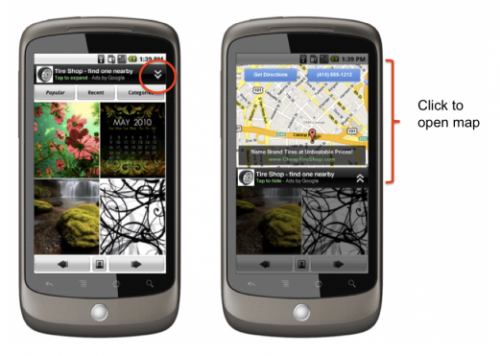Google’s New Mobile Ads Take Users From Search To Store
Earlier this summer Google rolled out Expandable Map Ads for mobile devices. These ads appear on the mobile web and in apps. To participate advertisers must enable location extensions and be opted in to the content network for mobile. They begin as a banner that expands when clicked into a map with the option to […]
Earlier this summer Google rolled out Expandable Map Ads for mobile devices. These ads appear on the mobile web and in apps. To participate advertisers must enable location extensions and be opted in to the content network for mobile.
They begin as a banner that expands when clicked into a map with the option to get directions or call a business. Here’s what those ads look like:
This is obviously powerful in that it can drive someone (literally and figuratively) to a specific store or location. The flaw, if there is one, is that the identification of nearby locations is based on IP targeting, which is imprecise.
Now Google has introduced a similar ad format for search that appears in Google Maps for Mobile and offers all the targeting capabilities that Maps provides: GPS and triangulation.
Beyond location specificity the other big difference is search intent. The display units discussed above appear in the content network. The new ads on Google Maps for Mobile appear in response to a search query.
The screens that Google provided show a Sprint-related search (these units are live now).
The user initiates a search for “Sprint,” in this example. You then see sponsored icons on the map. Not clearly pictured here is a banner for Sprint that appears at the top of the map. However that banner will disappear if not clicked. That’s a nice innovation.
Clicking on the banner or any of the location icons sends you to a Google Place Page for Sprint, which then gives you the ability to call a store or get directions. It also integrates seamlessly with Google navigation (or directions). So the ad literally can take users “from search to store.”
Like the content-network’s Expandable Map Ads, Google won’t charge for the click on the map icon or banner. Google will charge for calls or clicks on a URL.
Also like the Expandable Map Ads this is built on Location Extensions, which must be enabled (you also have to claim Places for the enabled locations). Google will only show one ad on the Map for any given search/query. The ad shown will depend on essentially the same set of factors that would determine what ads show in more traditional Google search (bid, CTR, ad quality). However Google is scoring mobile ads differently than PC ads.
The rules and requirements are relatively straightforward. These units have been testing for a number of weeks but Google wouldn’t share any performance data with me. Regardless, the capacity to take people from a search query to a physical retail store, restaurant or other location is both powerful and exciting.
It also starts to really take advantage of the properties and intrinsic capabilities of mobile vs. PC search.
It’s one thing to lead someone to a location when they’re already looking for it. But consider these units in a category or “generic” query context.
The Sprint ad shows up, for example, when I do a query for “wireless phones.” (In fact so did a similar AT&T ad, though not at the same time as the Sprint ad.) A search for “camping gear” delivers an ad for LL Bean. In my area (SF Bay Area) there are no LL Bean stores so it’s an e-commerce ad (which is not going to be that relevant to me in mobile). But REI could just as easily be the advertiser against “camping gear,” sending me to a local REI store. One could also easily imagine coupons or offers being integrated in ad copy and so on.
You start to see how effective these ads are likely to be, leading users to the point of sale. This has always been the promise of “local search” and it’s now starting to be realized on mobile devices with ad units like this.
Opinions expressed in this article are those of the guest author and not necessarily Search Engine Land. Staff authors are listed here.
Related stories

